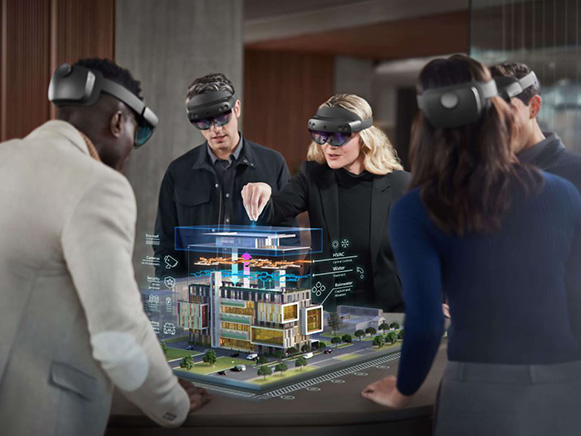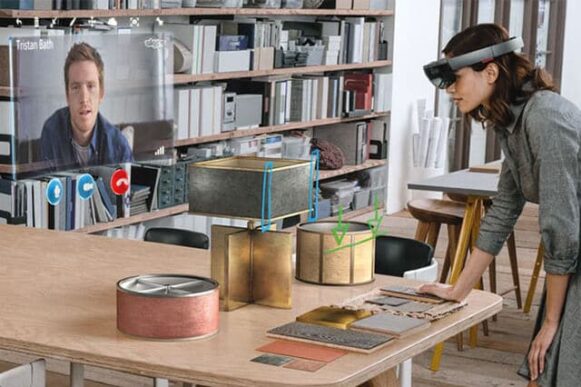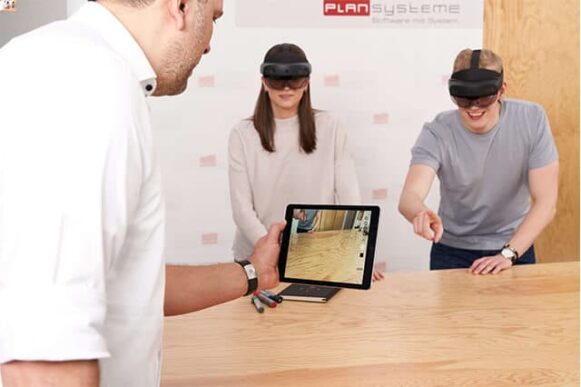HoloLens mixed reality app for construction
Hololens mixed reality app – AR apps or MR-App for civil engineers, architects, planners and builders are designed to speed up construction projects and relieve staff. Since every construction project brings its own challenges, a mixed reality app for construction must be powerful and customisable. Microsoft’s HoloLens 2 hologram glasses can do just that – as a standalone computing solution designed to help turn abstract ideas into (almost) tangible objects.
What can augmented reality do for construction?
The construction industry consists largely of planning and preparation. The longer a project drags on, the more expensive it becomes. But if all problems and planning errors are not eliminated, this can also delay the construction period and also make everything considerably more expensive.
A major problem for architects and building planners has always been that even with apparently very similar buildings and projects, individual adjustments are always necessary. Every project is unique and has site-specific characteristics that affect the amount of work involved.
Ultimately, translating the design created on the drawing board perfectly into the real and physical world requires a good spatial imagination on the part of everyone involved. It is obvious that not everyone has this. Thanks to augmented reality, however, construction projects can now be designed and planned much more efficiently.

Less abstract representations depict reality better

Instead of assuming abstract thinking on the part of everyone involved, HoloLens 2 Microsoft Hologram Glasses can be used to translate any construction project into clear, object-related data that can be viewed in the real environment.
It does not matter whether it is a completely virtual image, where everything is simulated, or augmented reality, i.e. the mixing of artificial and real parts. Compatibility with the software used by construction companies for planning and designs is important, however.
With the Microsoft AR glasses and the matching augmented reality app for construction, the HoloLens becomes an indispensable tool for architecture and construction. The mixed reality app uses the integration of so-called holograms into the real environment. Thus, a builder can already view his finished building from all sides at the construction site before the ground has even been broken.
Fewer measurement inaccuracies through augmented reality on the construction site
The HoloLens shows its advantages especially in interior design. For example, furnishings can already be virtually placed and examined in the shell of the building. What often looks good on paper later looks completely different in reality. On construction sites in particular, measurement errors lead to problems time and again.
With a powerful AR app for measuring rooms, the HoloLens 2 makes it easy to determine and check framework data and relate them to the later mixed reality simulation.

PLANSYSTEME
DO YOU HAVE ANY QUESTIONS? FEEL FREE TO CONTACT US!
Do not hesitate to contact us. In a first non-binding conversation we will find out how we can help you and whether our solutions fit you. We look forward to hearing from you!
Advantages of a mixed reality app for construction:

- Measuring is accelerated and more precise
- Design data is superimposed on the real environment
- Subjective interpretations of participants become less important
- Easy way to visualise designs
- Viewing the design in a real environment and in the context of the project
- Fewer quality problems due to detection of design errors at an early stage
- Less need for expensive rework
The HoloLens 2 already changes the rules of the game when it comes to architects
It is obvious that a mixed reality app is very useful in construction. But the architect can already make profitable use of the HoloLens 2 and AR apps for civil engineers when working out designs and coordinating with other participants such as clients or craftsmen.
A great advantage of this variant is that not only can the designs be viewed in a real context, but it also brings with it the possibility of modifying designs as desired.
As a builder, you can therefore try out different variants without incurring large costs or having to buy a pig in a poke. For architects and building planners, this means less effort and easier implementation of customer wishes even in the already advanced planning stage of a building project.

Conclusion: Mixed reality in construction can greatly relieve the burden on architects, construction planners, craftsmen and builders
The combination of powerful software in the form of an augmented reality app for construction with a HoloLens 2 is an almost perfect match. Without being spatially bound to each other, everyone involved in the project can coordinate with each other, suggest changes, eliminate sources of error and test the concepts in a real environment.
All this at any point in the construction phases. What already has obvious advantages for single-family homes can serve to convince investors in large construction projects or to find new solutions to planning problems that were previously almost impossible to solve. However, saving time, stress and ultimately money is probably the best argument for the construction and architecture industries to convince them to use data glasses with AR apps.


